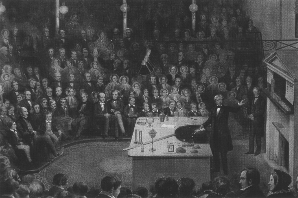
Natural Science - Year II
Fall Semester Review Unit

History Weblecture for Review I
| This Unit's | Homework Page | History Lecture | Science Lecture | Lab | Parents' Notes |
History Lecture for Fall Semester Review:
People and Concepts to Know
For Class
- Period: 1650-1900
- Geographic Location: Europe
- People to know: See list below
- See science topics: Science Theories
Outline/Summary
Biographical information
Be sure that you can identify the following major contributors with their scientific theories, and explain the importance of certain non-scientific texts and artifacts to the history of science. For each person on this list, you should know roughly when they lived (which century), their nationality, their contribution to science, and their relationship to others on the list. For example, Aristotle was a pupil of Plato, and the teacher and partner of Theophrastus; he also drew on the discoveries of the Milesian materialists like Thales and the theories of Eudoxus and Empedocles in forming his world view.
Now is the time to review the introductory unit discussion of study methods, and practice them diligently as you review the materials in units 34-49.
Study suggestion for people: make a timeline table! Organize the entries in first-to-last order by dates. This will help you identify early philosophers whose ideas might influence those who came later.
| Person or work | Period | Location | Contribution and Importance of Contribution | Influence or other Notes |
| John Dalton | fluent 1800-1820 | England | Chemist who reintroduced atomic theory, formulated laws of conservation of matter | Established laws of multiple combinations, whole-number ratios used to balance chemical reactions |
| Charles Darwin | fluent 1850-1870 | England | Wrote Origins of Species outlining theory of evolution and natural selection | Influenced modern evolutionists; but did NOT influence Gregor Mendel! |
Other ways to study this information: make flash cards, have your parents or siblings drill you. Write a biography entry on the Natural Science Glossary (extra credit) with the information you can find on the individuals below.
- Paracelsus
- van Helmont
- Franciscus Sylvius
- Robert Boyle
- Georg Stahl
- Joseph Priestley
- Joseph Black
- Henry Cavendish
- Antoine Lavoisier
- John Dalton
- Amadeus Avogadro
- Joseph Guy-Lussac
- Dmitri Mendeleev
- William Ramsay
- Nicolas Steno
- Georges Buffon
- Abraham Werner
- James Hutton
- William Smith
- Charles Lyell
- Louis Agassiz
- Alfred Wegener
- Jean Baptist Lamarck
- Jean Baptiste Robinet
- Charles Bonnet
- Georges Cuvier
- Charles Darwin
- Richard Owen
- J. H. Gladstone
- Samuel Wilberforce
- St. George Mivart
- Gregor Mendel
- James Watt
- Sadi Carnot
- James Joule
- Rudolf Clausius
- Herman von Helmholtz
- William Thomson
- Ludwig Boltzmann
- Thomas Young
- Augustin Fresnel
- William Herschel
- Robert Bunsen
- Gustav Kirchhoff
- Wilhelm Röntgen
- Arthur Compton
Essay Topics
The second part of the exam will ask you to put information together to draw conclusions about what happened, or why something that should logically have followed, didn't apparently happen.
The following are sample essay questions on historical topics we have covered, with some suggestions on how to tackle the topic. These are suggestions only; you might come up with something equally good. Just be sure to ground your claims in concrete examples drawn from the material we covered.
At least one question on the exam will be drawn from this list. Remember that an "essay" answer has several well-organized paragraphs that introduce your main point, describe two or more actual examples to support your point, and draw a good conclusion. One sentence does not (in this case) an essay answer make!
- Chose one of the following scientists and explain why his ideas first met with opposition when proposed: Antoine Lavoisier, Charles Darwin, Alfred Wegner. What happened to make the theory proposed more acceptable to society?
- How does the concept of matter change between the end of the Middle Ages and the mid-19th century? What "advances" in scientific methods make the reassessment of matter possible?
- How did studies of heat flow lead to changes in the concepts and use of energy and power and ultimately result in the laws of thermodynamics?
- The fossil record shows the abrupt end of several types of animals: they simply don't show up in later geological formations. Select two different geologist/biologists and describe how they explained the disappearance of species.
- Describe two ways scientists tried to explain the phenomena of light before 1850. What were the shortcomings and strengths of each theory?
Study/Discussion Questions:
- What characterizes a good essay?
- How do you identify broad generalizations and improve the precision of your work?
- How do you support claims in your essay on historical topics?
Further Study/On Your Own
- The Alpha History site has some good advice on writing history essays.
© 2005 - 2024 This course is offered through Scholars Online, a non-profit organization supporting classical Christian education through online courses. Permission to copy course content (lessons and labs) for personal study is granted to students currently or formerly enrolled in the course through Scholars Online. Reproduction for any other purpose, without the express written consent of the author, is prohibited.